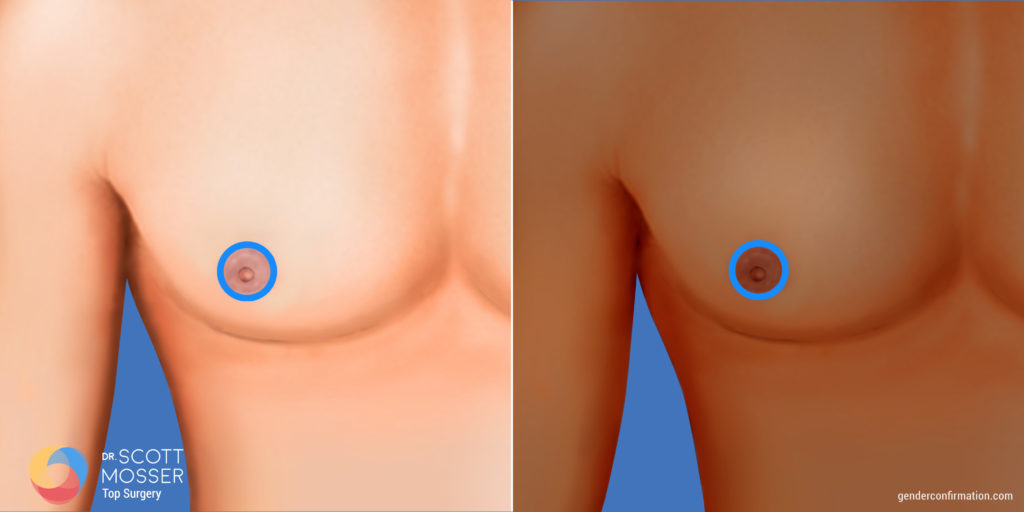Periareolar Procedure
Periareolar Top Surgery, also called the ‘donut’ or ‘circumareolar’ procedure, is a form of chest reconstruction top surgery, formerly known as FTM top surgery. It uses a circular incision around the areola which allows for removal of chest tissue, intermediate removal of skin, and reduction of areolar size. This article provides information on the challenges of this technique and effects on nipple sensation and chest tightness. Find out if you are a good candidate for this gender affirming procedure here.
What is the Periareolar Technique ?
The periareolar technique involves a donut shape of skin removal around the areola. This is performed by making the areola smaller (about 22 mm in diameter, which is similar to the areola size for cisgender men), and then marking an outer circle of skin which will be removed. The outermost layer of the skin is removed. Through this layer of tissue, the surgeon makes an incision and works beneath the layers of the skin to remove the chest tissue.
After the chest tissue has been removed, the surgeon performs a “purse string” stitch to bring the outer circle down to the diameter of the inner circle. Sometimes, this has the downside of creating a pleating effect, oftentimes called a sunburst or a ripple pattern around the nipple because of the mismatch between a large circle and a small circle. Most of the time, these ripples diminish or disappear completely in the weeks and months that follow surgery.
Periareolar Procedure and Intermediate Skin Removal
The periareolar procedure lies at a crossroads between keyhole surgery and other surgeries that may require more skin removal. This surgery is a good fit for patients who have more skin than would be appropriate for the keyhole surgery, but wish to have a procedure involving relatively minimal skin incision. However, this is one of the procedures that has a higher revision rate because of the challenges involved, so one has to keep that in mind when choosing this procedure.
Other names for the periareolar procedure are circumareolar and donut incision techniques. They all refer to the same thing, but periareolar is most commonly used. Some people call the procedure “peri” for short.
Periareolar Procedure Challenges
Achieving a perfectly uniform thickness across the entire chest can be a challenge even for the most capable of surgeons with this procedure. Therefore, it is not uncommon for there to be some very subtle ripples in the surface contour of the chest with this procedure. Although these minor irregularities can happen with any procedure, they are more common with the periareolar procedure, as compared to the double incision procedure.
Periareolar Procedure and Sensation
While most patients have a considerable decrease in sensation in their nipple or chest area immediately after surgery, the majority recover most or all sensation. This can be an advantage for patients who desire to retain their nipple sensation after surgery.
Periareolar Procedure and Excess Skin
While periareolar surgery has many advantages, it can only be used if the patient requires minimal excess skin removal. To get a better idea of which body type you have and therefore which surgical procedure is the best fit for, you click here. Using the periareolar technique on a patient with excess skin can result in a loose fold of skin in the lower chest or a pronounced pleating or sunburst pattern of wrinkling around the areola that does not go away.
We can never be 100% sure of how skin is going to react to any procedure, but there are parameters which can help you and your surgeon determine which procedure is the right one for you.
Chest Tightness with the Periareolar Procedure
For some patients, chest tightness is extremely important. If that is the case, the double incision technique will likely produce a better outcome than periareolar.
Sign Up For Instructions To Get a Virtual Consultation
The virtual consultation will be billed to your insurance company. We will accept the insurance reimbursement as payment in full.





